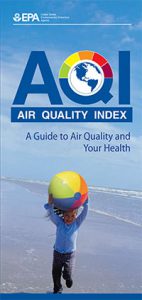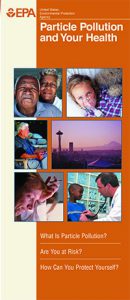HEALTH
Healthy Community = Healthy You!
When it comes to air quality, a little preventative medicine can go a long way in improving our overall health. It’s easy to do your share for cleaner air Learn about the health effects associated with ground-level ozone and particle pollution and pledge to make a difference today.
 Air pollution affects everyone. The average adult breathes more than 3,000 gallons of air every day. Children breathe even more air per pound of body weight and are more susceptible to air pollution.
Air pollution affects everyone. The average adult breathes more than 3,000 gallons of air every day. Children breathe even more air per pound of body weight and are more susceptible to air pollution.
In addition, those with sensitivities, such as children, elderly, people with heart and lung disease or in the summer, adults who exercise outside face problems when air pollutants rise beyond health standards.
Ground-level Ozone
Short term exposure to high levels of ground-level ozone irritates our lung airways causing inflammation. It can aggravate asthma and bronchitis and increase hospital admissions. Fourteen Americans die every day from asthma, a rate three times higher than 20 years ago. Children make up 40 percent of all asthma cases.
Ground-level ozone can make it more difficult for you to breathe as deeply and vigorously as you normally would. If you are exercising or working outdoors, you may notice that you are taking more rapid and shallow breaths than normal. Reduced lung function can be a particular problem for outdoor workers, competitive athletes and others who exercise outside.
Schedule your exercise routine for early morning or in the evening when the ozone pollutions are not at their peak. Pay attention to heat and air quality advisories and keep the very young, elderly and those residents with respiratory problems in a cool environment inside.
A Guide to Air Quality and Your Health
Particle Pollution
 The size of particles in particle pollution is directly linked to its potential for causing health problems. Small particles, less than 10 micrometers in diameter, pose the greatest problems, because they can get deep into your lungs, and some may even get into your bloodstream. Exposure to such particles can affect both your lungs and your heart. Larger particles are of less concern, although they can irritate your eyes, nose, and throat. Some particles are dark or large enough to be seen as soot or smoke. Others are so small that they can only be detected with an electron microscope.
The size of particles in particle pollution is directly linked to its potential for causing health problems. Small particles, less than 10 micrometers in diameter, pose the greatest problems, because they can get deep into your lungs, and some may even get into your bloodstream. Exposure to such particles can affect both your lungs and your heart. Larger particles are of less concern, although they can irritate your eyes, nose, and throat. Some particles are dark or large enough to be seen as soot or smoke. Others are so small that they can only be detected with an electron microscope.
Your chances of being affected by particle pollution increase the more strenuous your activity and the longer you are active outdoors. If your activity involves prolonged or heavy exertion, reduce your activity time or substitute another that involves less exertion. Go for a walk instead of a jog, for example. Plan outdoor activities for days when particle pollution levels are lower. And don’t exercise near busy roads; particle pollution levels generally are higher in these areas.
Particle pollution levels can be elevated indoors, especially when outdoor particle levels are high. Certain filters and room air cleaners can help reduce indoor particle pollution levels. You also can reduce particle pollution levels indoors by not smoking inside, and by reducing your use of other particle sources such as candles, wood-burning stoves, and fireplaces.